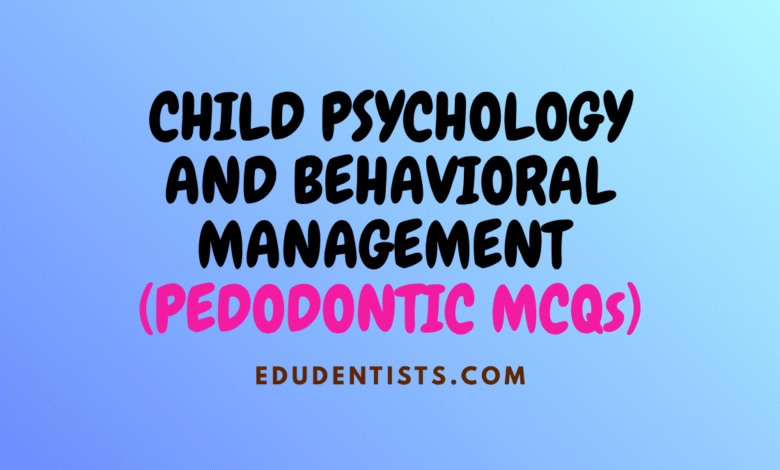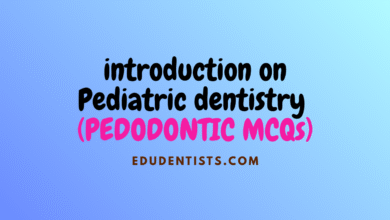INTRODUCTION, CHILD PSYCHOLOGY AND BEHAVIORAL MANAGEMENT _ PEDODONTIC MCQs

INTRODUCTION, CHILD PSYCHOLOGY AND BEHAVIORAL MANAGEMENT _ PEDODONTIC MCQs
1. Fear to strangers is known as:
A. Xenophobia
B. Clostrophobia
C. Arthrophobia
D. Claustrophobia
2. Compared to permanent dentition, primary dentition:
A. Enamel and dentin is more mineralized
B. Dentinoenamel junction is scalloped
C. Dentine is uniformly calcified
D. Enamel and dentin thickness is more
3. Earnest Klein has classified habits into
A. Compulsive and noncompulsive habits
B. Intentional and nonintentional habits
C. Primary and secondary habits
D. Pressure and nonpressure habits
4. All of the following are behavior modification (shaping) techniques in a normal child, except:
A. Desensitization
B. Contingency management
C. Modeling
D. Aversive conditioning
5. During what stage of development is peer group identity strongest?
A. Toddler
B. Latency
C. Teenager
D. Prepuberty
6. According to the intelligence quotient classification, a score of 120–139 is:
A. Very superior
B. Superior
C. High average
D. Average
7. Which of the following is commonly used for immobilization of the head in a noncompliant patient?A. Papoose board
B. Pedi-wrap
C. Forearm–body support
D. All of the above
8. Wright’s clinical classification of children’s cooperative behavior has _ categories:
A. 3
B. 4
C. 5
D. 2
9. Universally used method of behavior management in pediatric dentistry for both co-operative and uncooperative children is:
A. Voice control
B. Behavior shaping
C. Implosion therapy
D. Communication
10. Learning disability is otherwise known as:
A. Infantile psychosis
B. Minimal brain dysfunction
C. Childhood schizophrenia
D. Attention deficit disorder
11. Child of an overprotective overindulgent mother shows:
A. Shy, submissive behavior
B. Evasive and dawdling behavior
C. Demanding and aggressive behavior
D. Stoic behavior
12. The window of infectivity during which most children acquire the cariogenic organisms is between the ages of:
A. 15 and 16 months
B. 17 and 18 months
C. 19 and 33 months
D. 36 and 40 months
13. Fear of closed spaces like “dental clinics” is known as:
A. Nyctophobia
B. Zoophobia
C. Xenophobia
D. Claustrophobia
14. Film size -0 for bitewing radiograph is
A. 22 × 35
B. 24 × 40
C. 32 × 41
D. 50 × 60
15. Form and function originally given by:
A. Balters
B. Grabbers
C. Van Der Klaauw
D. Melvin Moss
16. EGO
A. Reality
B. Instinct
C. Moral value
D. Conscience
17. Anxiety
A. Fear of unknown
B. Fear to stranger
C. Fear to pain
D. Fear to object
18. Wechsler test is for all of the following, except:
A. Adoptive social behavior
B. Intelligence
C. Memory
D. IQ
19. To predict the occurrence of caries in a 10-year-old child, which of the following gives best result?
A. Sibling caries
B. Mother’s caries
C. Previous caries experience
D. Snyder’s test
20. Growth of children of different age groups is evaluated on different parameters at same point of time:
A. A longitudinal studies
B. Cross-sectional
C. Cross-longitudinal
D. Interventional
21. Neonatal teeth are
A. Teeth that erupt at birth or within 30 days after birth
B. Teeth that erupt after the 120 days
C. Teeth that erupt within 45 days
D. Teeth appearing in 180 days
22. Egocentrism and animism are seen in which stage?
A. Sensorimotor
B. Preoperational
C. Concrete operations
D. Formal operational stage
23. Discontinuation of nursing bottle should be done at:
A. 6 months
B. 9 months
C. 12 months
D. 18 months
24. Pulse-oximeter is used to determine:
A. Rate of blood flow
B. Oxygen saturation
C. Blood volume
D. Blood coefficient
25. According to Piaget, period of concrete operations is:
A. Birth to 18 months
B. 12 years and onward
C. 18 months to 7 years
D. 6–12 years
26. The nonpharmacologic technique that has remained a corner stone of behavior management is:
A. Tell-show-do
B. Averse conditioning
C. Hand over mouth exercise
D. Voice control
27. Father of Pedodontics in India:
A. Dr. BR Vacher
B. Dr. Rafiuddin Ahmed
C. Robert Bunon
D. Bowen
28. The theory of “Hierarchy of need” is given by:
A. Freud
B. Maslow
C. Pavlov
D. Skinner
29. Frankel’s Behavior Rating Scale includes how many classes?
A. 2
B. 3
C. 4
D. 5
30. By what age a child can sit without support?
A. 4 months
B. 6 months
C. 12 months
D. 15 months
31. A child visiting a dentist for the first time has basic fear of:
A. Unknown
B. Equipment
C. Tooth extraction
D. Pain
32. Projection and introjection are explained by which theory?
A. Freud
B. Maslow
C. Erikson
D. Maslow
33. Animism corresponds to
A. Sensorimotor stage
B. Formal operation stage
C. Concrete operation stage
D. Preoperational phase
34. The suckling reflex and infantile swallow normally disappear by the:
A. First year
B. Second year
C. Sixth year
D. Eighth year
35. A child patient demonstrating resistance in dental office is usually manifesting:
A. Anxiety
B. Anger
C. Inborn fear
D. Immaturity
36. According to Frankel Behavioral Rating Scale, a child who accepts dental treatment but cautious at times is rated as (Positive):
A. Rating 1
B. Rating 2
C. Rating 3
D. Rating 4
37. Classical conditioning occurs when two stimuli are paired together:
A. When child’s action are reinforced or rewarded
B. When two stimuli are paired together
C. When multiple stimuli are paired together
D. When child’s actions are bribed and praised
38. Ontology means
A. Our way of being
B. Study of ear
C. Both A and B
D. None of these
39. “The silent epidemic” is:
A. Dental disease
B. Swine flu
C. Cholera
D. None of these
40. CMCP stands for
A. Calcium mono-parachlorophenol
B. Camphorated mono-chlorobenzophenone
C. Camphorated mono-meta chlorophenol
D. Camphorated mono-parachlorophenol
41. The primary reason for aggressive behavior of a 5-year-old child in a dental office is:
A. Fear
B. Separation from parents
C. Pain
D. Unknown
42. The most common type of epilepsy in children is:
A. Grand mal epilepsy
B. Infantile spasm
C. Petit mal
D. None of the above
43. The fear of a 6-year-old related to dentistry is primarily:
A. Subjective
B. Objective
C. Subjective and objective
D. Psychological
44. The approximate age at which the child begins to walk is at:
A. 0–2 months
B. 3–6 months
C. 7–8 months
D. 9–12 months
45. The most common congenital defect of the face and jaws is:
A. Macrosomia
B. Fetal alcohol syndrome
C. Cleft lip and palate
D. Ectodermal dysplasia
46. According to Stanford–Binet, nontrainable type of mental retardation has an IQ of:
A. Below 20
B. Between 36–51
C. Above 51
D. 130
47. Which of the following theories of child psychology was proposed by Pavlov?
A. Operant conditioning
B. Classical conditioning
C. Social learning theory
D. Cognitive theory
48. Radiographs of the jaws of a newborn child ordinarily indicate calcification of
A. 12 teeth
B. 16 teeth
C. 20 teeth
D. 24 teeth
49. The best time to begin the counseling of parents and establishing a child’s preventive program actually starts
A. Before the birth of the child
B. Infants (0–2 years)
C. Toddlers (1–3 years)
D. Preschool (3–6 years)
50. In case of conscious sedation for children aged 6 months to 3 years, clear liquids should be stopped:
A. 4 hours before the procedure
B. 6 hours before the procedure
C. 8 hours before the procedure
D. 10 hours before the procedure
51. Best time to see a 3-year-old child in the dental office is:
A. Early in the morning
B. Just before lunch
C. Just after lunch
D. Any time
52. The ratio of Head:Body at 2–3 months IU life is
A. 1:2
B. 1:24
C. 1:8
D. 1:12
53. By what age does the startle and grasp reflex disappear?
A. 1 year
B. 1 ½ year
C. 2 years
D. 3 years
54. Pacifier sucking is an example of
A. Digit sucking
B. Nonnutritive sucking
C. Implicative sucking
D. Nutritive sucking
55. For a 3-year-old child, a removable space maintainer is fabricated. What is the biggest disadvantage of this appliance?
A. Irritation to supporting tissues
B. Difficult to clean
C. Child may not tolerate wearing
D. Function will be compromised
56. “Whistle” is a word substitute for explaining which of the following instruments in children?
A. High-speed hand piece
B. Suction apparatus
C. Low-speed hand piece
D. Air syringe
57. Joseph Wolpe developed the following behavior management technique
A. Modeling
B. Tell-show-do
C. Desensitization
D. Voice control
58. Bean bag is used in dental chair for the following purpose
A. Restraining body
B. Restraining head
C. Comfort of patient
D. In spondylitic patients
59. What is to be done in the initial stage of behavior modification in children?
A. Adaption
B. Awareness
C. Evaluation
D. Motivation
60. Number of arms in rubber dam retainer is:
A. 4 prongs + 4 jaws
B. 2 prongs + 4 jaws
C. 4 prongs + 2 jaws
D. 2 prongs + 2 jaws
61. The first ADA-approved fluoride toothpaste for OTC (Over-the-counter) was in the year:
A. 1945
B. 1955
C. 1964
D. 1971
62. Fear of Strangers and Fear of Separation from parents for the children will be diminished by:
A. First birthday
B. Fifth birthday
C. Third birthday
D. Seventh birthday
63. During development of speech function, the first speech sounds acquired are
A. Bilabials
B. Consonants
C. Sibilants
D. Nasolabials
64. The following is not a communicative management technique according to American Academy of Pediatric dentistry’s Standards:
A. Voice control
B. Positive reinforcement
C. Physical Restraint
D. Distraction
65. According to Piaget, the period of concrete operations is:
A. Birth to 18 months
B. 12 years and onward
C. 18 months to 7 years
D. 7–12 years
66. Behavior management techniques were labeled as “Embarrassment of Riches” in 1977 by:
A. Jimmy R Pinkham
B. Gerald Z Wright
C. David W Chambers
D. J C Brauer
67. According to the Freudian psychosexual stages of development the stage which corresponds with development of mixed dentition and character formation is:
A. Concrete operational
B. Latency
C. Phallic
D. Genital
68. In behavior modification, what is the most common route for premedication?
A. Oral
B. Intramuscular
C. Subdermal
D. Intravenous
69. In an uncooperative child, the last resort is:
A. Physical restraints
B. Modeling
C. Desensitization
D. HOME
70. In a 3½-year-old uncooperative child, which of the following should be best for dental procedures?
A. Modeling
B. Physical restraints
C. HOME
D. Desensitization
71. If the use of a technique on a child is objectionable enough that the child will co-operate in order to avoid it, that technique will come under:
A. Pharmacological domain
B. Physical domain
C. Aversive domain
D. Reward-oriented domain
72. In a 9-year-old child, permanent teeth with highest prevalence of caries is:
A. Labial surface of canine
B. Mesial surface of central incisors
C. Occlusal surface of first molar
D. Lingual surface of lateral incisor



